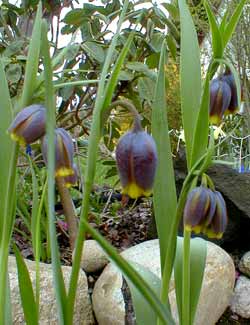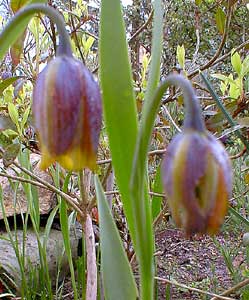
Uva-Vulpis Fritillary;
aka, Fox's Grape;
aka, Assyrian Frits
"A fox is a wolf who sends flowers."
-Ruth Weston,
November 1955
November 1955
Fox's Grape (Fritillaria uva-vulpis synonymous with F. assyriaca) is variable in height, sometimes as tall as fourteen inches, often well under a foot, & generally shorter their first year in the ground than thereafter. The flower stem occasionally reaches 18 inches. When the leaves pop out of the ground in February they are at first short pointed onion-dome shaped spoons, then mature & elongate into grassy blades.
In Autumn 2002 we planted twenty-five Fox's Grape bulbs around our 'Milestone' Rhododendron. In autumn 2003 we planted ten more (purchased from a different source as Fritillaria assyriaca) under the mail box amidst redolent Narcissus x odorus Campernelle daffodils.
Because the frits can stand to be planted shallowly to as little as two or three inches depths (& five inches apart), they can be layered over more deeply planted daffodils. The Campernelles bloom ahead of the fritillaries then overlap.
 This native of Iran, Iraq & Turkey flowers at the tail end of March, lasting all through April & well into May. They grow wild in some very harsh areas, so as garden plants they're usually happy & hardy, possibly the easiest of all fritillaries. It is sometimes recommended to plant fritillary bulbs on their sides, as their "split" or cracked shape otherwise permits them to accumulate water in their hearts so that they could rot rather than fully perennialize.
This native of Iran, Iraq & Turkey flowers at the tail end of March, lasting all through April & well into May. They grow wild in some very harsh areas, so as garden plants they're usually happy & hardy, possibly the easiest of all fritillaries. It is sometimes recommended to plant fritillary bulbs on their sides, as their "split" or cracked shape otherwise permits them to accumulate water in their hearts so that they could rot rather than fully perennialize. Beneath the soil, fritillary bulbs shed their outer shell while in flower, & spend the rest of the seasons not so much dormant as growing a new bulb within the old.
Although they can do nicely in partial shade, here in the Northwest they prefer full afternoon sun. Unless Fox's Grape is placed in too wet a location, it should naturalize & return each year with increasing vigor. They last only one year then vanish in damp or too-often-watered locations. When they like a location they will also seed freely, though it'll be a few years before seeds become flowering bulbs.
Their pendant flowers are dusty purple or chocolatey brown on the outside, yellow in the inside, with petals turned out just enough to reveal a lip margin of bright yellow. If they could be positioned atop a hill to be seen from a lower path, they would look much more yellow with the insides visible.
Though not the equal of F. meleagris or F. michaelowsky in visual impact, this fritillary does have a subtle wildflower grace & charm. The upright stems are oddly hinged or bent, making it look a bit like the fritillary is dangling from a hangman's beam.
The Fox's Grape has more DNA than any plant or animal yet discovered. It adds up to around twenty-five times the amount of DNA in each cell of a human being. Why this frit needs so much DNA information is unknown, but I'm sure there's a science fiction story in there somewhere.